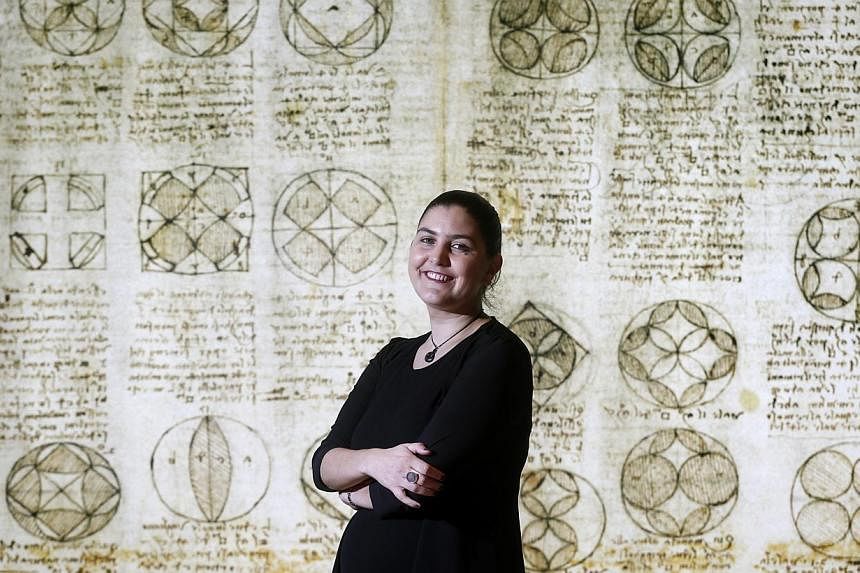It was a long, emotional night last Sunday for ArtScience Museum executive director Honor Harger. She was waiting eagerly for the arrival of Leonardo da Vinci's works, which had travelled a long way from their home, Biblioteca Ambrosiana, a prestigious cultural institution in Milan, Italy.
This is the first time the Renaissance man's original drawings and writings have come to South-east Asia. A total of 26 folios from his largest illustrated manuscript, the Codex Atlanticus, and six paintings modelled after his classic works, will be on display at the museum's new show, Da Vinci: Shaping The Future. It opens to the public tomorrow.
Ms Harger, 39, says: "You can only bring a Leonardo da Vinci to an entire region for the first time, once. And to be there to document that moment when the works touched down was pretty special. It was emotional."
The New Zealand-born curator has been working on the show since March when she took over the reins at the museum from Mr Nick Dixon. She was previously artistic director at Lighthouse, a digital culture agency in the United Kingdom that supports, commissions and shows work by artists and film-makers.
For her, the experience of welcoming the da Vinci works, which marry art, science and technology, was also significant because it embodies her hope for the museum - to be a place where these disciplines intersect and "where the future is made".
One of her key roles, she says, has been "defining more sharply" the museum's identity. She began by reflecting on its achievements in its three-year history - it made possible large-scale touring exhibitions from world-class lending institutions - and the original vision for it.
She says: "From the beginning, the museum was described as a place that would explore the unity of arts and sciences. We want to return to that vision."
There has been talk, especially among museum lovers, that the ArtScience Museum fell short of its remit with shows such as one on Harry Potter, the titular boy wizard of J.K. Rowling's bestselling series of books, which featured props and costumes used in the movies that the book inspired.
Asked about this, she says evenly: "It's not for me to reflect on the decisions of my predecessor. We're very much focused on the now and future... our curatorial philosophy that speaks to the intersection between art, science, technology and culture."
She has done this in her first eight months by launching programmes such as ArtScience Late. At the monthly event, the museum extends its closing time from 7 to 10pm and features a specially commissioned live performance by artists and technologists from different backgrounds. The museum will host the Singapore Maker Festival next month to support the do-it-yourself community to come up with inventive products using art and technology.
Similarly, the current exhibition, An Ocean Of Possibilities, presented in partnership with the Singapore International Photography Festival and Noorderlicht, a platform for photography in the Netherlands, highlights the coming together of art, science and culture. Photographs in the show examine how people have set out to realise a better future amid economic and political failings.
Ms Harger was the first webcasting curator for London's renowned Tate Modern museum, curating art and technology events from 2000 to 2003. She was director of the AV Festival, the UK's largest biennial of media art, film and music, from 2004 to 2008.
As an artist, one of her main projects was Radio Astronomy, a radio station broadcasting sounds from space, which she produced with artist Adam Hyde under the name radioqualia. She says: "The intersection of art and science has been where I've been working creatively for the better part of 15 years and this is the only art-science museum in the world."
However, she is now a "mostly retired" artist. "When you start directing arts institutions, it becomes difficult to sustain your practice. You find your creative voice in a different way. When you curate exhibitions and put together events, that becomes the medium through which you are telling stories."
The narrative at the da Vinci show centres on the Renaissance man as someone "whose work remains strikingly resonant and relevant". She emphasises this by including five contemporary art installations, including new commissions of works by Singapore artist Donna Ong and home-grown architectural firm WY-TO.
Ms Harger says: "Perhaps Leonardo da Vinci's greatest contribution to our present moment is that he worked so fluidly between disciplines. If we were picking a figure in history to showcase our vision for the future, we couldn't find a more iconic figure."

